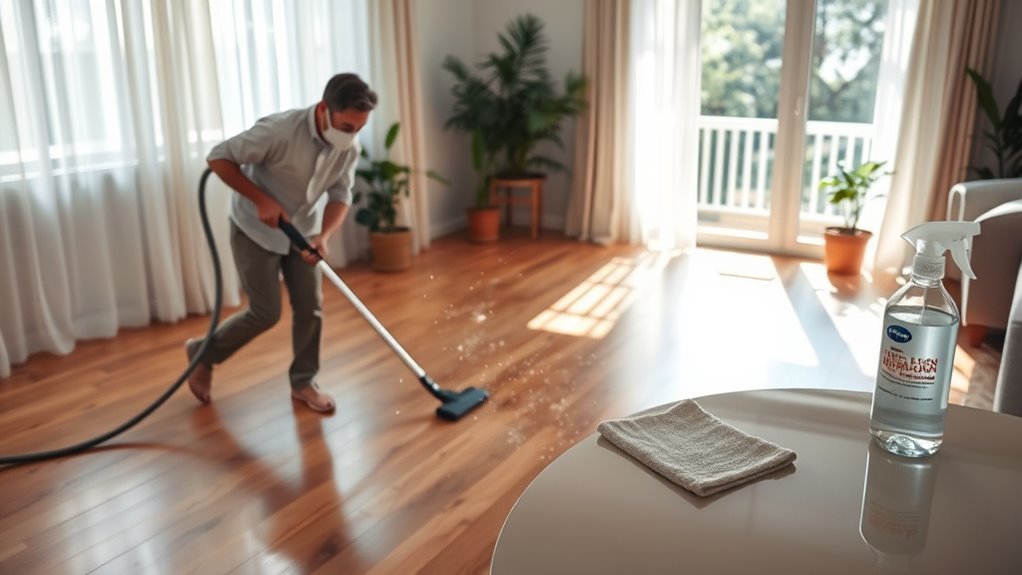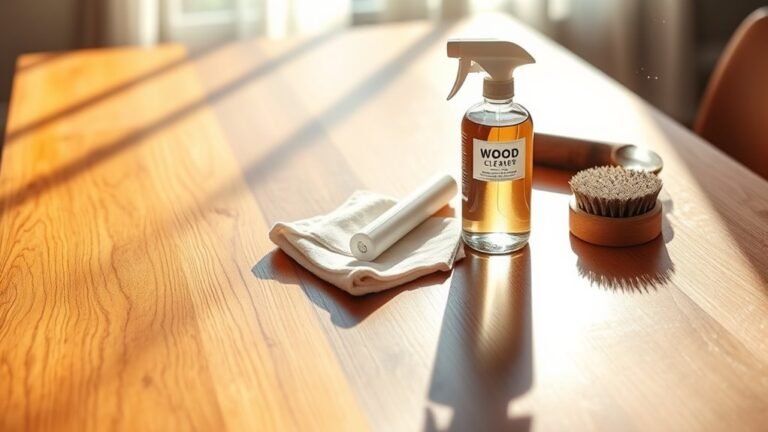How to Clean Your Home After Allergens
To clean your home after allergens, first identify common triggers like dust mites, pet dander, and mold. Gather supplies such as microfiber cloths, HEPA vacuums, and eco-friendly cleaners. Dust surfaces with a damp cloth, vacuum carpets and upholstery thoroughly, and wash bedding and curtains in hot water regularly. Don’t forget to clean air vents and use air purifiers to reduce airborne allergens. Stick to a regular cleaning routine, and you’ll breathe easier while improving your space’s comfort. There’s more to discover for allergen-free living.
Identify Common Household Allergens
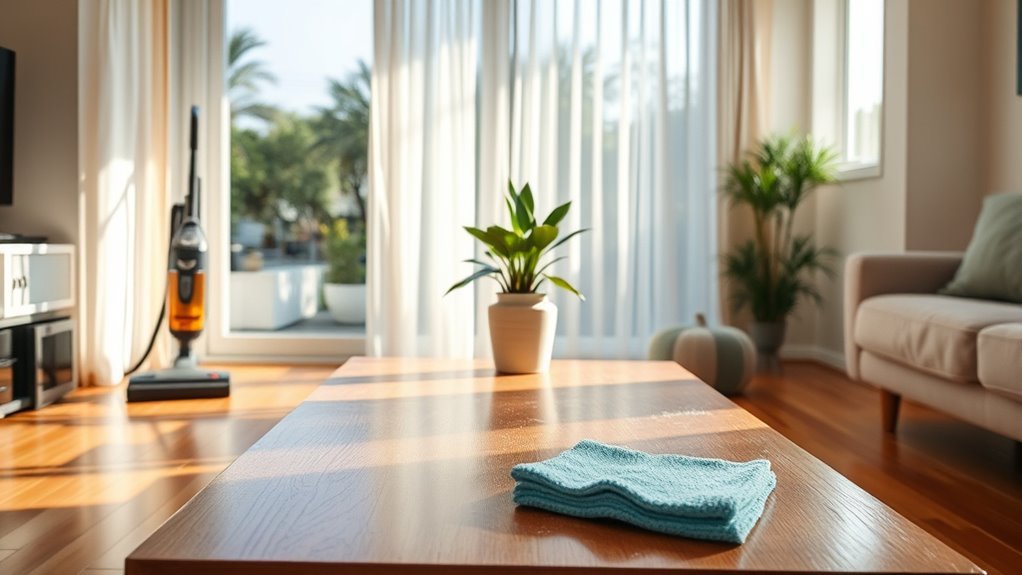
Before you begin cleaning, it’s important to identify the allergens commonly found in your home. You might not realize how much pet dander lingers in your living space, especially if you have furry friends. These tiny particles can easily become airborne, triggering allergies and limiting your freedom to enjoy a comfortable environment. Mold spores are another hidden culprit, often hiding in damp corners or behind walls. They thrive in moisture and can cause respiratory issues if left unchecked. By recognizing these common household allergens, you can target your cleaning efforts more effectively. This clarity lets you reclaim your space without unnecessary hassle, making your home a sanctuary where you’re in control of your health and comfort.
Prepare Your Cleaning Supplies
Now that you’ve pinpointed the allergens lurking in your home, gathering the right cleaning supplies will make tackling them much easier. Choose cleaning tools that efficiently trap dust and allergens, like microfiber cloths and HEPA-filter vacuums. Opt for eco friendly products to keep your space safe and reduce chemical exposure. Here’s a quick guide to get you started:
| Cleaning Tools | Eco Friendly Products |
|---|---|
| Microfiber Cloths | Plant-based All-Purpose Cleaner |
| HEPA Vacuum | Natural Enzyme Cleaner |
| Rubber Gloves | Essential Oil Disinfectant |
| Dust Mop | Baking Soda |
| Spray Bottles | Vinegar |
With these supplies ready, you’re set to reclaim your home’s freedom from allergens—clean smart and breathe easy.
Dust Surfaces Thoroughly and Safely
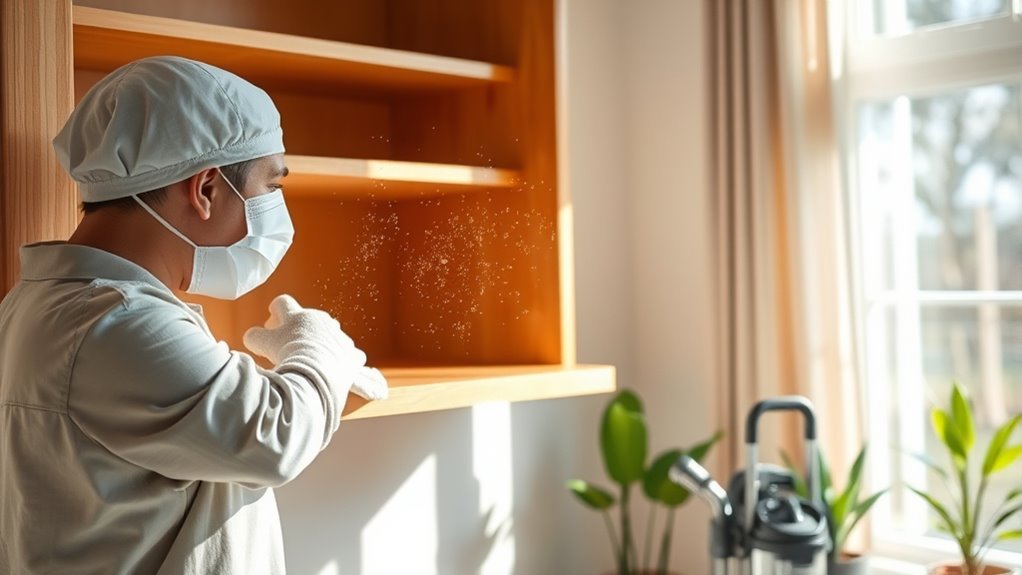
Dusting your home thoroughly and safely is key to reducing allergens that settle on surfaces. To keep your space fresh and allergen-free, focus on using eco friendly products paired with effective techniques. This approach not only protects your health but also the environment, giving you the freedom to live clean and green. Here’s how you can do it right:
Thorough, safe dusting with eco-friendly products keeps your home allergen-free and environmentally healthy.
- Use microfiber cloths; they trap dust instead of spreading it around.
- Lightly mist your cloth with an eco friendly cleaning spray to capture particles better.
- Dust from top to bottom, starting with ceiling fans and shelves to prevent re-contamination.
- Avoid dry dusting which can kick allergens into the air, opting instead for damp dusting.
Vacuum Carpets and Upholstery Effectively
Vacuuming your carpets and upholstery effectively is essential to remove hidden allergens that settle deep within fibers. To get the best results, choose a vacuum suited for your specific carpet types—whether plush, Berber, or shag—since each demands a different approach. For upholstery materials like leather, microfiber, or cotton, use attachments designed to protect the fabric while lifting dust and pet dander. Move the vacuum slowly to allow the suction to pull out trapped particles. Don’t forget to vacuum under furniture and cushions where allergens hide. Regularly empty or replace vacuum bags and filters to prevent allergens from escaping back into your space. By tailoring your vacuuming to your home’s unique surfaces, you’ll reclaim a fresher, freer living environment.
Wash Bedding and Curtains Regularly
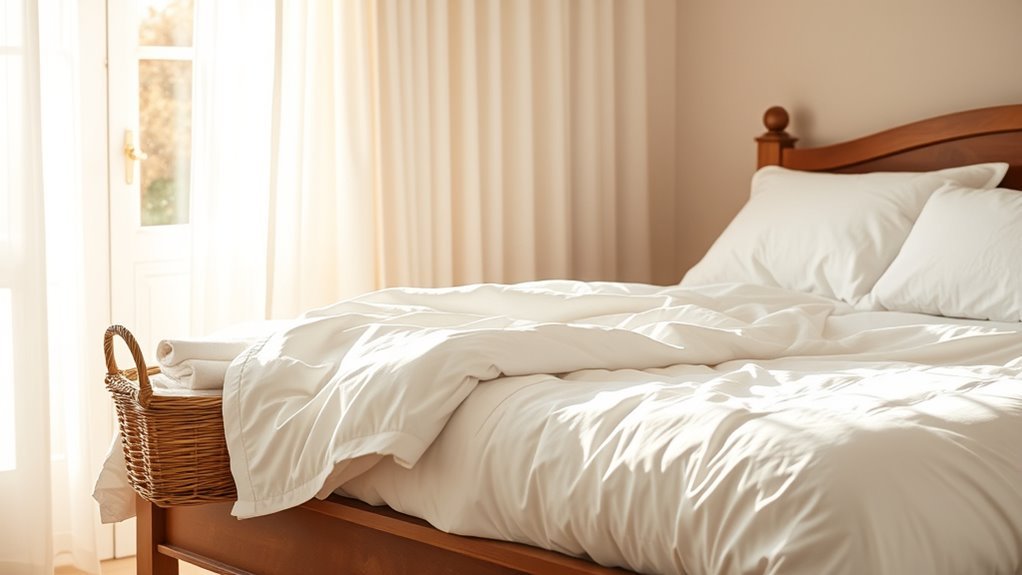
Since allergens like dust mites and pet dander easily accumulate on fabrics, you should wash your bedding and curtains regularly to keep them under control. This simple habit frees you from constant sneezing and irritation by removing trapped allergens from your bedding materials and curtain fabrics.
Regularly washing bedding and curtains helps remove allergens, reducing sneezing and irritation effectively.
To make the most of your cleaning:
- Use hot water cycles to kill dust mites and remove allergens effectively.
- Opt for hypoallergenic detergents to avoid adding irritants.
- Wash bedding weekly, including pillowcases, sheets, and blankets.
- Clean curtains every few weeks or as recommended based on their fabric type.
Clean Air Vents and HVAC Systems
Keeping your bedding and curtains clean is a great start, but allergens can also build up in your air vents and HVAC systems. To truly breathe freely, prioritize vent maintenance and duct cleaning. Regularly inspecting and cleaning these systems prevents dust, pollen, and mold from recirculating indoors.
| Task | Frequency |
|---|---|
| Inspect air vents | Every 3 months |
| Replace HVAC filters | Every 1-3 months |
| Professional duct cleaning | Annually |
| Clean vent covers | Monthly |
| Check for mold | Biannually |
Use Air Purifiers to Reduce Airborne Allergens
Although regular cleaning helps, airborne allergens can still linger in your home’s air. Using an air purifier is a smart step to regain control and breathe freely. The air purifier benefits include trapping dust, pollen, pet dander, and mold spores, making your space healthier. When choosing filters, opt for HEPA filters, which capture particles as small as 0.3 microns.
Air purifiers trap allergens like dust and pollen, improving your home’s air quality and health.
Keep these tips in mind:
- Select a purifier sized for your room to maximize efficiency.
- Replace filters regularly to maintain peak performance.
- Consider purifiers with activated carbon filters to reduce odors.
- Position the purifier away from walls for better air circulation.
Maintain a Regular Cleaning Schedule
You’ll want to stick to a regular cleaning schedule to keep allergens in check. That means dusting daily, vacuuming weekly, and doing a deep clean once a month. Consistency is key to making your home a safer, healthier space.
Daily Dusting Routine
Since allergens can settle quickly, establishing a daily dusting routine helps you stay ahead of buildup and keeps your home healthier. You don’t have to spend hours; a focused effort with the right cleaning tools and dusting techniques makes all the difference. Use microfiber cloths or electrostatic dusters that trap particles instead of spreading them around. Here are some tips to create an effective daily dusting routine:
- Target high-touch surfaces like shelves, tables, and window sills
- Dust from top to bottom to avoid redistributing allergens
- Shake out or wash dusting tools regularly to maintain efficiency
- Incorporate gentle, controlled movements to avoid stirring up dust
Weekly Vacuuming Schedule
Vacuuming your home at least once a week is essential for keeping allergens under control and maintaining a cleaner living space. Sticking to a consistent cleaning frequency helps prevent dust, pet dander, and pollen from accumulating. To make the most of your efforts, focus on effective vacuuming techniques: use slow, deliberate strokes and overlap each pass to capture hidden particles. Don’t forget to vacuum upholstered furniture and curtains where allergens love to settle. If you can, choose a vacuum with a HEPA filter to trap even the smallest irritants. Keeping this weekly routine frees you from constant worry about allergens, giving you more time to enjoy your space comfortably and confidently. Regular vacuuming isn’t just a chore—it’s your ticket to a fresher, healthier home.
Monthly Deep Cleaning
Keeping up with your weekly vacuuming sets a solid foundation, but tackling a monthly deep cleaning helps you address allergens hiding in less obvious spots. Sticking to a regular cleaning schedule lets you breathe easier and enjoy your home freely. Use a detailed cleaning checklist to guarantee you don’t miss anything important during your monthly session. Combine this with seasonal cleaning to adapt your efforts to different allergen challenges throughout the year. Focus on:
- Washing curtains and bedding in hot water
- Dusting ceiling fans, vents, and light fixtures
- Cleaning under furniture and behind appliances
- Vacuuming mattresses and upholstery thoroughly
Frequently Asked Questions
Can Certain Houseplants Reduce Indoor Allergens?
Yes, you can use air purifying plants to help reduce indoor allergens. When you choose low allergen varieties, you’re less likely to trigger sneezing or irritation while still enjoying cleaner air. These plants naturally filter toxins and improve air quality, giving you a fresher, healthier space without relying on chemicals. So, pick some low allergen air purifying plants to breathe easier and keep your home feeling free and comfortable.
Are Hypoallergenic Pets Better for Allergy Sufferers?
Imagine curling up with a furry friend without sneezing or itchy eyes. Hypoallergenic breeds can help you enjoy that freedom since they shed less dander, which often triggers allergies. But it’s not just the breed; regular pet grooming is key to keeping allergens at bay. So, if you want to share your space with a pet while staying allergy-free, choosing a hypoallergenic breed and staying consistent with grooming routines is your best bet.
How Do Humidity Levels Affect Allergen Presence?
You’ll find that humidity levels play a big role in allergen presence. When humidity’s too high, it encourages mold growth and dust mites to thrive, which can make your space uncomfortable. Keeping humidity between 30-50% helps keep those allergens in check, letting you breathe easier and enjoy your freedom without constant sneezing or irritation. Using a dehumidifier or proper ventilation can really make a difference in maintaining that balance.
What Natural Cleaning Products Are Safest for Allergy Sufferers?
You’ll want to go for natural cleaning products like a vinegar solution—it’s great at cutting through grime without harsh chemicals that trigger allergies. Adding a few drops of essential oils, like lavender or tea tree, not only freshens up your space but also offers antibacterial benefits. Since you value freedom, these DIY options let you control what goes into your home, keeping it clean and safe without compromising your health or lifestyle.
Can Allergen-Proof Mattress Covers Improve Sleep Quality?
Imagine your bed as a fortress guarding your dreams—an allergen-proof mattress cover acts as its sturdy shield. By providing mattress protection, it blocks dust mites and allergens, creating a cleaner sleep environment. This barrier supports better sleep hygiene, letting you breathe freely and wake refreshed. When you embrace this freedom from irritants, your nights become peaceful escapes, helping you reclaim restful sleep and the energy to face each new day with ease.
